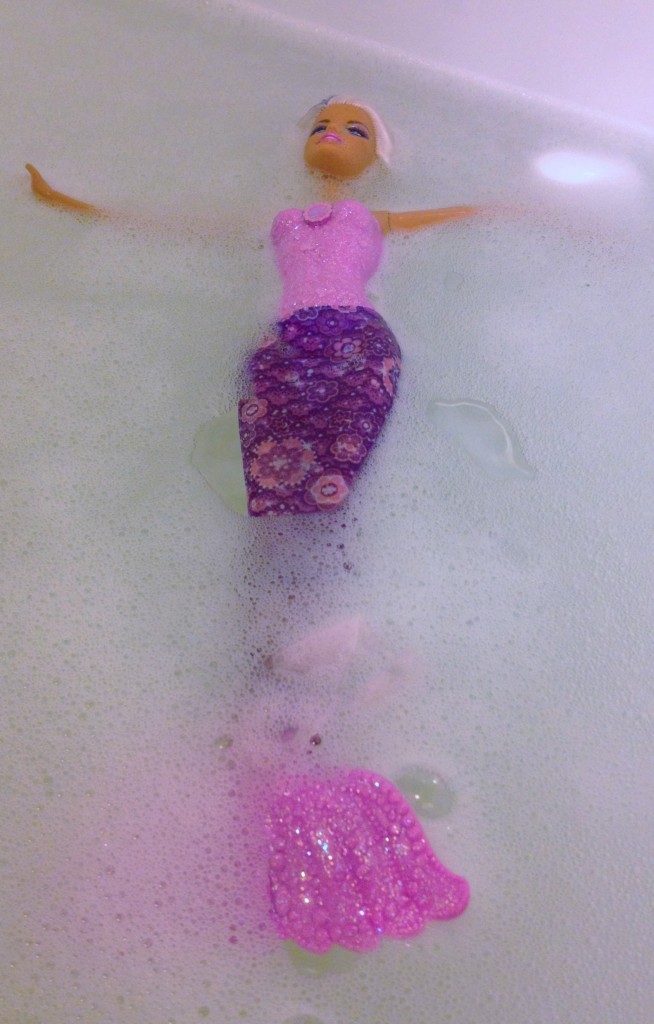When my second child was born, we were over-the-moon excited that she was a girl (we didn’t know the gender before either of our children’s births), because now we had one boy and one girl! I was determined to raise my boy and my girl just the same, giving them all the same toys and allowing them to each choose their own play preferences, regardless of toys labeled “for boys” or “for girls”.
Inevitably, gender-related toys crept in, though. First it was the cars and trucks given to my son as gifts. Then my daughter, and around 18 months old, started showing the desire to cuddle things and play with baby dolls. I was surprised to find that I wanted to get her more dolls. I had been reluctant to reinforce the baby doll thing because I don’t want to promote the idea that her only goal in life should be to become a wife and mother. Not that she shouldn’t have those choices, but that those should not be her only considerations for her future.
Similarly, I was torn when it came to Barbie dolls. I played with Barbie dolls growing up. To be perfectly honest, I probably continued to play with Barbies up to a much older age than most girls. But even though I emerged unscathed from my Barbie coma, I am aware that there are valid reasons not to allow your girls to play with Barbie.
Body image – It’s no secret that the Barbies I played with as a child had completely unrealistic measurements. Her bust-to-waist ratio would have been physically unsustainable for a human woman. In 1997, Mattel modified Barbie’s body to a more physically viable ratio by widening her waist, but it’s still obviously a perfect model body that is unrealistic for most women. Barbie has been blamed repeatedly by feminists for the epidemic of eating disorders in young women. The idea is that by supplying our young, impressionable children with this unrealistically proportioned doll, we are silently telling them that this is what we expect them to look like.
Barbie’s shallow lifestyle – She’s basically a fashion model. She spends her time in a dream house, in a convertible, on the beach, and going shopping. Even when she has been a doctor or a scientist, the goal is to dress her up and take her out with her boyfriend after work. How shallow, a good feminist would say. Women are so much more than their clothes, their possessions, and their boyfriends. True, but who says that is what girls will always pretend to do with Barbie? When I played with Barbie in my tweens, I was actually using her and her friends to reenact the Young Adult fiction books I was constantly reading.
Inherent consumerism – Barbie is nothing without her accoutrements. The clothes, the purses, the mermaid tail, the RV, the aforementioned house and car. Everything you use to create her world must be bought. The argument goes that Barbie is teaching our children that they need to buy more and more things to be happy, to make Barbie happy.With this one point, I disagree. My primary Barbie-playing friend and I used to use all kinds of things we found around our houses to create homes and apartments for Barbie. Boxes, ribbon from gifts, vases, small pillows for her bed, buttons and broken jewelry for her house embellishments. My mother and my friend’s mother made some of the Barbie’s clothing. Buying all those things for Barbie is a choice that can be made by the parents.
She is made of evil plastic – I wouldn’t be a good “green” blogger if I didn’t mention that Barbie is made of PVC. This was actually my biggest problem with Barbie. In case you aren’t aware, PVC is known to leech phthalates and other endocrine disrupting (hormone affecting) chemicals as it ages, especially if it is warmed. I won’t even buy rain boots for my children made out of PVC, but here I am considering purchasing a Barbie doll.
With all the negative potential for Barbie to turn my daughter into a fluffy headed anti-feminist covered in phthalates, what did I decide to do?
I bought her first Barbie for her this Christmas.
The truth is, I enjoyed my Barbies. I never felt pressured to look like Barbie. As fellow contributor Heather pointed out, Barbie can also teach manners and positive values. Barbie fostered a lot of creativity for me in putting together her clothing, designing her houses, and creating or mimicking stories for her. While she is made of PVC plastic, my daughter also rarely puts things into her mouth at the age of 2 anymore, so I doubt she’ll be coming in direct contact with Barbie’s body like she would be with an article of clothing. She doesn’t seem interested in sleeping with her head next to PVC Barbie, and if she did, I would tell her that we do not get to take Barbie with us to bed.
Like all parenting decisions, perhaps we’ll modify our stance later. Maybe we’ll put limits on the number of Barbies or Barbie items. She’ll probably have to buy at least some of the accessories with her own money. Then again, maybe she won’t even be interested in Barbie at all.
What about you? Have you or will you allow your girl(s) to have Barbie? Why or why not?
















I love this article! I’ve felt very conflicted about my eldest daughter playing with Barbie; the more-so as it seemed to spur in her a desire to wear makeup and…uh…Barbie-type clothes. (She literally said to me: “But look at how pretty Barbie’s eyes and lips look!”). However, my 4 year old plays with the same dolls and has had none of those same “effects”. Kids are all different, and they all play with things differently. [Confession: I DID and have continued to steer my girls toward the old-school My Little Pony’s that I’ve found on craigslist.]
Oooh My Little Ponys on Craigslist? I would love that too! I was equally conflicted about My Little Pony even though Little Lady loves horses. That’s interesting about different girls — I only have one so I did not know! I will have to keep an eye on those differences in future kids. All children are different, even siblings!
I completely agree with your article! I grew up with Barbies but my parents never bought me any if the accessories or clothing. I created my own little world, my mom sewed a little mattress and pillow and taught me how to sew her clothes when I got a bit older. I think Barbie can just as easily be a teaching tool as it can be a negative impact. I don’t have any problem buying my daughter a Barbie when she becomes interested (she’s more interested in cars and trains at 19 months than dolls) but I will only be buying her a basic Barbie and will help her make her own Barbie accessories.
Great post. Although now I’m embarrassed that it never occurred to me Barbie was toxic, literally. Haha. But, I had the same struggle. I went in thinking we’d never have Barbie or Princesses at our house. I didn’t want my girl to be caught up in all that fantasy…She needed to be grounded in reality. But, since I have realized that I’m the one who she learns from…if I take that job seriously, then Barbie is not threat. If I let the media and her dolls be the only ones teaching her – then there may be trouble.
Thanks for informative post!